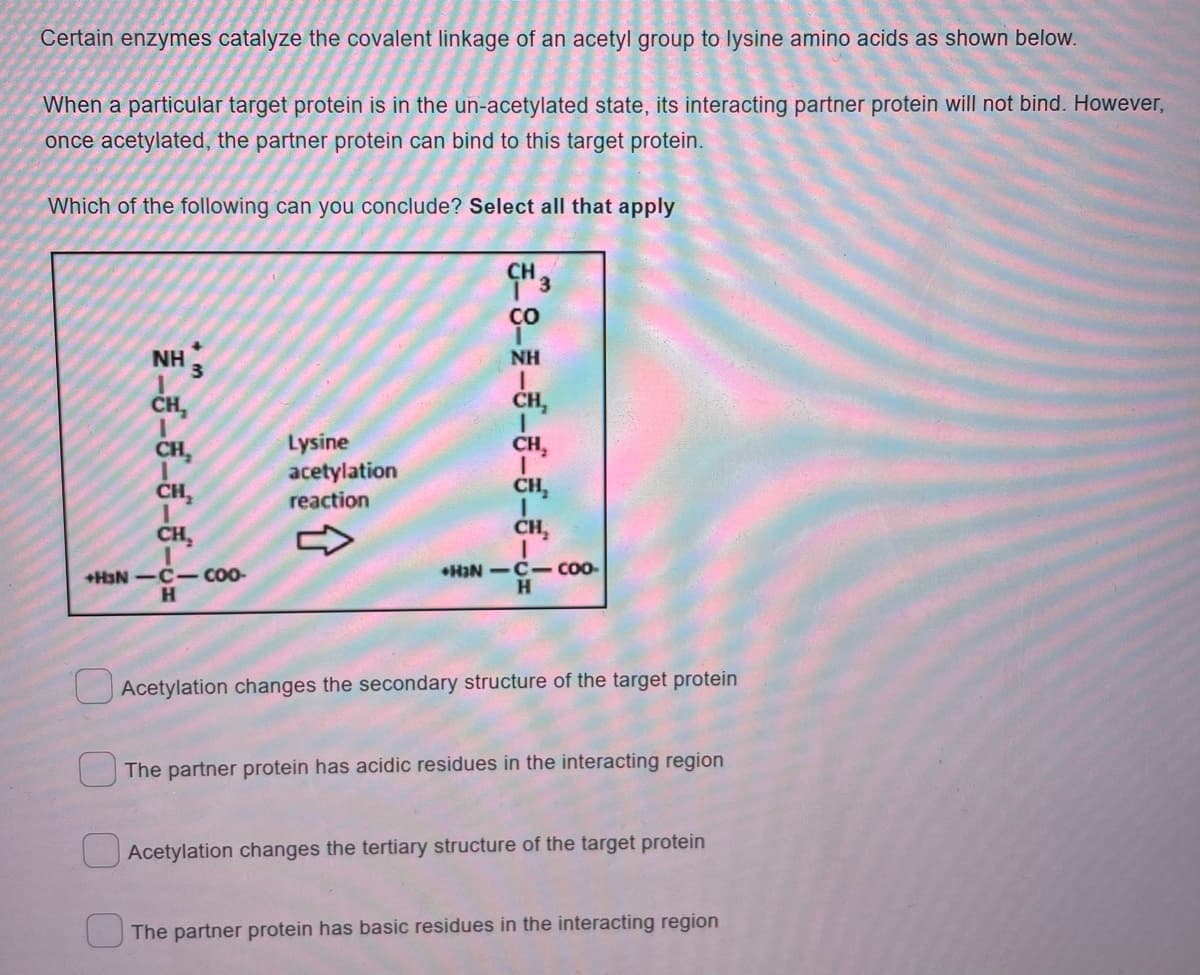Certain enzymes catalyze the covalent linkage of an acetyl group to lysine amino acids as shown below. When a particular target protein is in the un-acetylated state, its interacting partner protein will not bind. However, once acetylated, the partner protein can bind to this target protein. Which of the following can you conclude? Select all that apply CO NH NH CH, Lysine acetylation reaction CH, CH, +HaN -C- COO- H. HIN -C- CO- HA Acetylation changes the secondary structure of the target protein The partner protein has acidic residues in the interacting region Acetylation changes the tertiary structure of the target protein The partner protein has basic residues in the interacting region
Certain enzymes catalyze the covalent linkage of an acetyl group to lysine amino acids as shown below. When a particular target protein is in the un-acetylated state, its interacting partner protein will not bind. However, once acetylated, the partner protein can bind to this target protein. Which of the following can you conclude? Select all that apply CO NH NH CH, Lysine acetylation reaction CH, CH, +HaN -C- COO- H. HIN -C- CO- HA Acetylation changes the secondary structure of the target protein The partner protein has acidic residues in the interacting region Acetylation changes the tertiary structure of the target protein The partner protein has basic residues in the interacting region
Human Anatomy & Physiology (11th Edition)
11th Edition
ISBN:9780134580999
Author:Elaine N. Marieb, Katja N. Hoehn
Publisher:Elaine N. Marieb, Katja N. Hoehn
Chapter1: The Human Body: An Orientation
Section: Chapter Questions
Problem 1RQ: The correct sequence of levels forming the structural hierarchy is A. (a) organ, organ system,...
Related questions
Question

Transcribed Image Text:Certain enzymes catalyze the covalent linkage of an acetyl group to lysine amino acids as shown below.
When a particular target protein is in the un-acetylated state, its interacting partner protein will not bind. However,
once acetylated, the partner protein can bind to this target protein.
Which of the following can you conclude? Select all that apply
CH
CO
NH
3.
NH
Lysine
acetylation
reaction
CH,
CH,
+HaN -C- CO-
H.
HIN-C- Co-
H.
UAcetylation changes the secondary structure of the target protein
The partner protein has acidic residues in the interacting region
Acetylation changes the tertiary structure of the target protein
The partner protein has basic residues in the interacting region
8-1-8-8-8–8–d=
Expert Solution
This question has been solved!
Explore an expertly crafted, step-by-step solution for a thorough understanding of key concepts.
This is a popular solution!
Trending now
This is a popular solution!
Step by step
Solved in 2 steps

Recommended textbooks for you

Human Anatomy & Physiology (11th Edition)
Biology
ISBN:
9780134580999
Author:
Elaine N. Marieb, Katja N. Hoehn
Publisher:
PEARSON

Biology 2e
Biology
ISBN:
9781947172517
Author:
Matthew Douglas, Jung Choi, Mary Ann Clark
Publisher:
OpenStax

Anatomy & Physiology
Biology
ISBN:
9781259398629
Author:
McKinley, Michael P., O'loughlin, Valerie Dean, Bidle, Theresa Stouter
Publisher:
Mcgraw Hill Education,

Human Anatomy & Physiology (11th Edition)
Biology
ISBN:
9780134580999
Author:
Elaine N. Marieb, Katja N. Hoehn
Publisher:
PEARSON

Biology 2e
Biology
ISBN:
9781947172517
Author:
Matthew Douglas, Jung Choi, Mary Ann Clark
Publisher:
OpenStax

Anatomy & Physiology
Biology
ISBN:
9781259398629
Author:
McKinley, Michael P., O'loughlin, Valerie Dean, Bidle, Theresa Stouter
Publisher:
Mcgraw Hill Education,

Molecular Biology of the Cell (Sixth Edition)
Biology
ISBN:
9780815344322
Author:
Bruce Alberts, Alexander D. Johnson, Julian Lewis, David Morgan, Martin Raff, Keith Roberts, Peter Walter
Publisher:
W. W. Norton & Company

Laboratory Manual For Human Anatomy & Physiology
Biology
ISBN:
9781260159363
Author:
Martin, Terry R., Prentice-craver, Cynthia
Publisher:
McGraw-Hill Publishing Co.

Inquiry Into Life (16th Edition)
Biology
ISBN:
9781260231700
Author:
Sylvia S. Mader, Michael Windelspecht
Publisher:
McGraw Hill Education